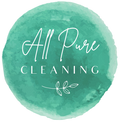7 Common Cleaning Mistakes and How to Avoid Them for a Healthier Home

Cleaning is a necessary part of maintaining a healthy and happy home, but even with the best intentions, there are common mistakes that can hinder your efforts. These mistakes not only leave your home dirtier than you'd like, but they can also introduce harmful chemicals or damage surfaces.
I've put together seven cleaning mistakes people often make and how to avoid them to create a truly healthy, eco-friendly living space:
1. Using Too Many Harsh Chemicals
Many people believe that the stronger the cleaning spray or product, the better the results, but over-reliance on harsh chemicals can harm your health and the environment. Products containing bleach, ammonia, or other toxic substances may irritate your skin, lungs, and eyes, and they can leave harmful residues on surfaces. Some also don't do exactly what we think they do - for example, bleach simply "bleaches" mould in pourous surfaces but it doesn't kill it. The reason being is that mould spreads its' roots deep into porous surfaces.
Solution: Opt for natural, non-toxic cleaners made from ingredients like vinegar, baking soda, 3% hydrogen peroxide or plant-based surfactants. These alternatives are just as effective and much safer for your home and the planet. If you prefer ready-made cleaners, make sure they’re eco-certified and/or free from harmful chemicals.
2. Not Letting Cleaning Products Sit Long Enough
A common mistake is spraying a surface with a cleaning product and immediately wiping it away. For most products, especially natural ones, you need to give the cleaner time to work a little before wiping it off.
Solution: Allow cleaning products to sit for at least a few minutes to break down dirt and grime. For tougher jobs like grease or bathroom mould, leave the solution on for 10-15 minutes to ensure it works effectively. Patience is key to achieving better cleaning results!
3. Using the Same Cloth or Sponge for Everything
Reusing the same cloth or sponge for multiple surfaces can spread germs and dirt instead of removing them. This is especially problematic in areas like kitchens and bathrooms where bacteria thrive. Also, different cloths are often made for different surfaces (such as a microfibre cloth tends to be fluffier and better for dusting and/or standard wiping/cleaning, whereas a glass cloth has a tighter weave and is best for glass/mirrors to avoid microfibre fibres being left behind).
Solution: Use colour-coded or designated cloths for different areas of the house (e.g., one for the bathroom, another for the kitchen) and use the right cloths for the right spots. Wash your cleaning cloths regularly in hot water and replace sponges frequently. Microfibre cloths are an eco-friendly option that can be washed and reused hundreds of times.
4. Ignoring the Importance of Ventilation
Many people clean enclosed spaces, like bathrooms or kitchens, without ensuring proper ventilation first and foremost. This can trap moisture, leading to mould growth, and increase the concentration of any fumes or chemicals in the air, even from natural cleaners.
Solution: Always open windows or use exhaust fans when cleaning (and also important to do so when showering or using a dryer in the house to avoid moisture build up). Fresh air helps circulate and remove any lingering fumes or moisture, creating a healthier indoor environment. It’s especially important when using vinegar or essential oil-based cleaners, as they can have strong smells that might irritate some people when being used despite being natural.
5. Overloading Cleaning Tools
Vacuum cleaners, washing machines, and dishwashers all work best when they aren’t overloaded. Overfilling these appliances makes it harder for them to effectively clean surfaces or items, and it may lead to breakdowns or wear and tear over time.
Solution: Make sure to follow manufacturer guidelines on how much you can load into your washing machine, or dishwasher and ensure you are properly maintaining your vacuum cleaner. Clean filters, brushes, and other components of your appliances regularly to keep them functioning efficiently. Running these tools at optimal capacity is better for both cleaning results and energy savings.
6. Skipping Regular Deep Cleaning
It's easy to fall into the routine of surface cleaning, but neglecting deeper cleaning tasks can lead to a build-up of dust, allergens, and hidden grime. Areas like baseboards, behind appliances, and air vents often go overlooked but are crucial for maintaining a truly clean and healthy home.
Solution: Schedule regular deep cleaning sessions every few months to address hard-to-reach or forgotten areas. For example, move furniture to vacuum underneath, wash blinds, and clean behind your fridge or stove. This will keep your home not only looking clean but also reduce allergens and improve air quality.
7. Using Too Much Product
More isn’t always better when it comes to cleaning products. Using too much cleaner can leave residue on surfaces that attracts more dirt or even cause damage over time. Plus, it’s wasteful and not eco-friendly at all.
Solution: Follow the product’s recommended instructions for use. A small amount of cleaner goes a long way, especially if you give it enough time to work. This not only prevents residue build-up but also saves you money and reduces waste.
Final Tips for a Healthier, Cleaner Home
- Go Natural: Choose eco-friendly, non-toxic cleaning products whenever possible. Your health and the environment will thank you.
- Clean Regularly: Don’t wait until messes become overwhelming. A little cleaning done regularly helps maintain a consistently healthy home.
- Focus on High-Touch Areas: Pay extra attention to areas like light switches, door handles, and remotes, which are frequently touched but often neglected during cleaning.
By avoiding these common cleaning mistakes and following more mindful, eco-friendly practices, you can keep your home sparkling while protecting your family’s health and minimising environmental impact.
A clean home doesn’t just look better... it feels better, too!

Leave a comment